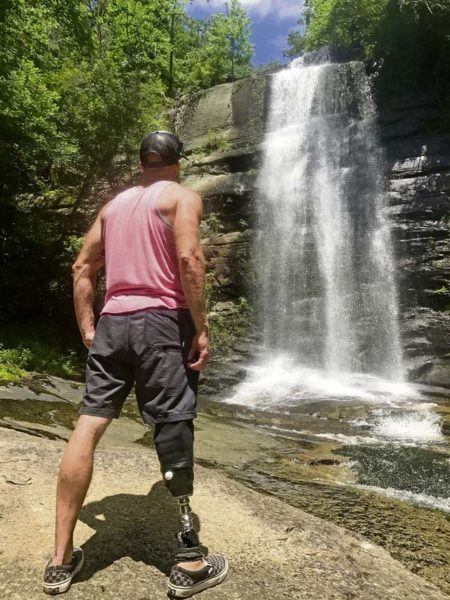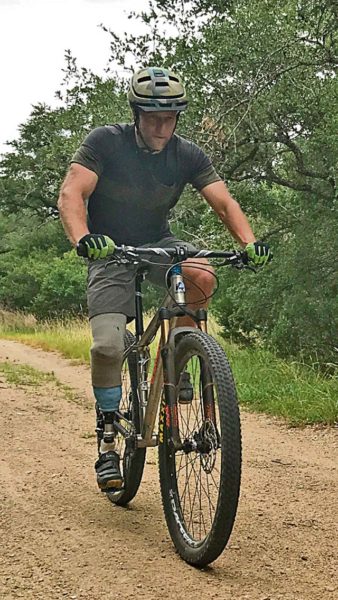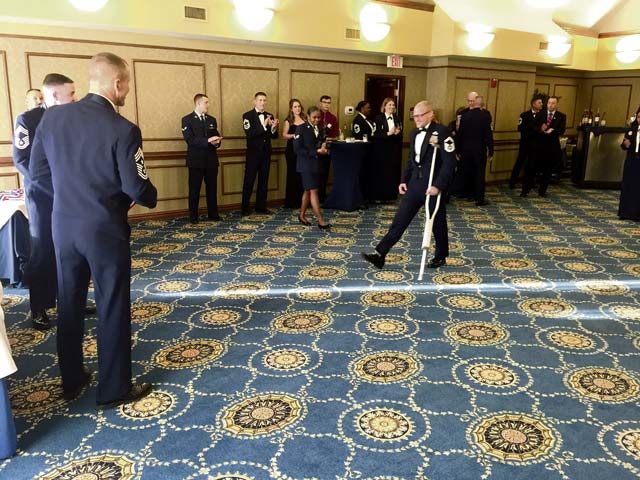
FALLS CHURCH, Va. — A mysterious pain in Chief Master Sgt. Chad Caden’s right foot led to years of pain, uncertainty, and a life-changing decision that proved to be the best one he ever made. Caden’s recovery and return to active duty reinforces the Air Force Medical Service’s commitment to its Airmen and patient-centered care.
In 2011, Caden, the chief enlisted manager with the 633rd Civil Engineer Squadron at Joint Base Langley-Eustis, noticed pain in his right ankle and foot. With nothing showing up on any x-rays and finding the pain somewhat bearable, Caden chose to live with the discomfort for a couple of years.
Over the years, Caden’s pain worsened and simple tasks became too much to handle. During his deployments between 2013 and 2015, it was determined he was dealing with a severe case of tendonitis. Motivated to continue his job, Caden diligently followed the physical therapist’s instructions.
“I was doing everything they told me, from stretching and icing it, to rolling it out and wrapping it,” said Caden. “Despite that, it hurt to stand, I had little mobility in my ankle, and it felt as if the pain was only getting worse.”
Back from deployment in 2015, Caden knew his pain was due to something other than tendonitis. Daily tasks were becoming increasingly difficult, and standing was becoming impossible. He decided to see an on-base patient advocate to help direct him to the appropriate level of care and find the true source of his pain.
“After an MRI, the primary care physician called me and said ‘I completely understand why you have been complaining,’” explained Caden. “The doctor said my ankle bone was completely dead and had not been receiving blood flow for some time.”
Caden was diagnosed with Osteonecrosis, a bone disease due to a loss of blood supply to the bone. This causes the bone tissue to die and collapse. While most people diagnosed with the disease know the cause, such as traumatic injury or an autoimmune disease. For Caden, his diagnosis is one of the 10 percent of cases with an unknown cause.
While Caden was concerned about his diagnosis and the possibility of it spreading to other bones, he knew he had to focus on finding a solution. Caden met with both military and civilian physicians to find the treatment option to help him return to his active lifestyle and remain in the Air Force.
“By this point my quality of life was drastically reduced from dealing with the chronic pain,” said Caden. “I received a procedure that aimed to restore blood flow to the bone, and a special brace that would take load off my feet. In the end, it made things worse. I felt more discomfort and the bone was only becoming deader.”
Caden soon realized the most effective solution to finally rid himself of this pain would be amputation. On Dec. 27, 2016, Caden received an amputation on his right leg, 6 inches below his knee.
“I was confident that my quality of life would be better if I got the amputation,” said Caden. “Aesthetics were not important to me, it was all about being active again.”

Courtesy photo
Equipped with a new prosthesis, Caden wanted to have the best chance of recovering and quickly returning to duty. He and his physicians agreed that a 90-day recovery at Walter Reed National Military Medical Center was the best option. It was there he learned how to walk on his prosthesis, and how to ride a bike again. The care and the support he received played a significant role on both his recovery and outlook on his amputation and prosthesis.
“I could not have had a better recovery,” explained Caden. “Three months there put me a year ahead of schedule. Just being there with so many other people going through the same thing as you makes it a lot easier. The physical therapists were also key in ensuring I could return to my active lifestyle and was safely progressing towards that goal.”
Caden’s primary care physician at JBLE also provided ongoing care and support vital to his recovery.
“She has been a huge advocate for me,” said Caden. “She always listens to my concerns at every step of my recovery, and has directed my care where it needs to be and made sure that I would be able to remain in the Air Force.”
From his diagnosis to his physical therapy with a prosthesis, Caden’s providers at Walter Reed and JBLE made him the central part of his care. Because of this, Caden continues to serve in the Air Force and returned to his active lifestyle. Almost a year after his amputation, Caden was not only able to pass his Air Force physical fitness test, he also successfully completed a 100-mile bike race.
“Getting the amputation was the best decision I ever made,” said Caden. “The care I received at every step are hard to quantify and played a big role in my recovery. There was never a time where I wished for my leg back, I wanted my life back. With the pain gone and a new prosthesis, I am focused on looking forward and establishing a new normal.”



